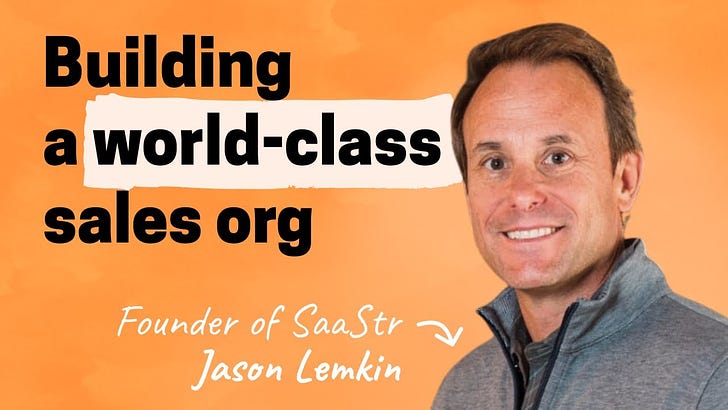8 Top Takeaways from Lenny Rachitsky + Jason Lemkin on "Building a World-Class Sales Org"
"Founders aren’t that patient in sales. You have to learn both urgency and patience in sales."
So just a little while back,
had me on his hyper-popular podcast (and Substack) to talk about scaling sales, from the perspective of a founder who hasn’t really done sales.It ended up being super popular, and a fresh take on a lot of topic we talk about a lot on SaaStr. I still regularly get emails about it, and the full deep dive is above. It’s great.
What I missed was Lenny’s own summary of his Top Takeway from our deep dive.
They really are a great checklist when you are starting to scale sales in SaaS. So I thought I’d do a deep dive on them here:
#1. Hire your first salesperson when you have closed the first 10 customers and are spending more than 20% of your time on sales. Don’t be swayed solely by impressive resumes or acronyms; instead, seek out those individuals who you would personally buy your product from.
A great summary of so many of our learnings. Try to close the first 10-20 customers yourself beyond you hire 1-2 reps, so you know how to do it. And once you do hire a sales team, and especially a VP of Sales — don’t exit sales. Way, way too many founders do this. And sales go down, not up.
#2. Instead of rushing to hire a VP early in the startup phase, wait until you have established a repeatable sales process and witnessed success with initial sales reps hitting quota. Hire a VP of Sales to help you scale from three sales reps to 300 reps.
This really summarizes it all in terms of when to hire a VP of Sales. To get you from reps 3 to 300. Not to figure out product-market fit, or to literally be the first seller.
#3. Make sure your VP of Sales actually wants to sell, not just manage.
This is one of my very top issues in hiring a VP of Sales recently. Folks are tired, burnt out, or just plain been doing it for too long as a VP of Sales to want to still sell themselves. It’s a tough job. And a lot of folks want to manage but not really sell themselves. Maybe that’s OK at $100m, $200m ARR. Not today, not for 99% of you. More here.
#4. If your salespeople are making substantial money, it’s a sign that the company is succeeding and the equity of both the reps and the founders is increasing in value. Therefore, don’t be discouraged if your sales team members are making significant earnings, as it correlates with the overall success and growth of the business.
You really do want your top 1-2 reps in the early days making good money. Not for nothing, for closing a lot. It inspires the rest of the team. It shows them it can be done.
#5. Involve sales in product development to ensure alignment between customer needs and product roadmap. Initiate a weekly meeting between the VP of Sales and the VP of Product to discuss the budget allocation for feature requests and prioritize it. This regular interaction ensures that both teams are aligned on priorities and helps prevent last-minute disruptions.
I see way, way too many startups where the VP of Sales doesn’t have a feature budget from engineering / product. And where every week, it’s some new input and critical feature that’s needed from sales. Add more structure here, and everything gets better.
#6. Unlike building a product team, there is no efficiency when building a sales org: half of your headcount will be in sales at $10m, $50m, or $100m in revenue. This means building a sales org requires a different approach. Jason recommends that founders follow the “rule of eights” when scaling their sales org: 8 sales reps need a manager, 8 account or sales executives need a director, and a VP may have 8 senior reports.
So much here in just a few sentences. It’s tough for founders to grok 40%+ of their headcount forever may be in sales. But there are no efficiencies there.
#7. A common mistake founders make is expecting to close the deal in the first or second meeting. Instead, you should play the long game. Ensure that there are clear next steps after every meeting, even if it’s doing a demo for someone else in the company. The best salespeople don’t throw a Hail Mary—they advance the ball into the red zone. Once you’re in the red zone, that’s when you ask for money and close the deal.
Founders aren’t that patient in sales. You have to learn both urgency and patience in sales. Big deals don’t close in a week. But once you have 10, 15, 20 of them in process — they do close regularly. Get a bit zen about long sales cycles.
Wow such a great convo! Check it all out above or here in Lenny’s pod:


